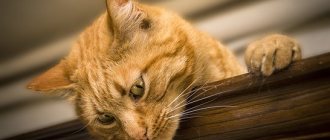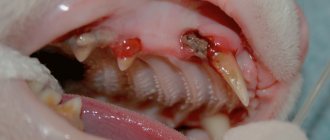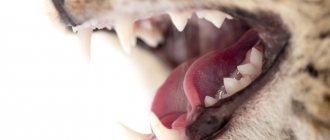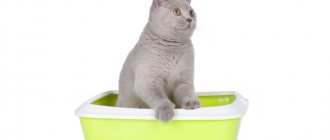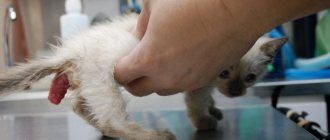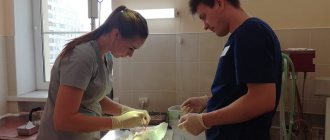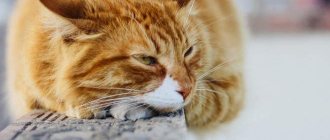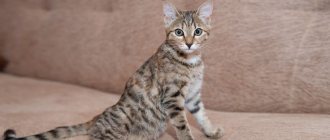Inflammation of the colon in a cat
Symptoms of colon inflammation in a cat
- Diarrhea.
- Problems with bowel movements.
- Mucus in the stool (sometimes bright red blood).
- Nausea (about 30% of cases).
- Sometimes - weight loss.
Treatment of colon inflammation in cats
First of all, contact your veterinarian. It will help identify and eliminate the cause of the inflammatory process.
Strictly follow the veterinarian's recommendations. In some cases, changing your diet is enough, but anti-inflammatory drugs may also be needed.
Diagnostics
To quickly diagnose the cause of intestinal inflammation in a pet, it is advisable for the owner to collect feces and vomit into clean bags or jars before going to the veterinary clinic. This is necessary so that a specialist can quickly examine them to identify parasites and toxic substances, as well as pathogenic bacteria.
You might be interested in: What can cause a cat to foam at the mouth?
In a veterinary clinic, the doctor will examine the cat and palpate the abdominal cavity. Further, if necessary, an ultrasound, x-ray and biopsy will be performed. Blood and urine tests are almost always necessary. If serious disorders in the colon are suspected, a colonoscopy is performed. An accurate diagnosis is made only after a complete examination of the animal.
The primary presumptive diagnosis is determined by the clinical picture and the results of testing for parasites. Treatment is also immediately carried out to eliminate dehydration and support the heart. In case of severe pain, anesthesia is performed using injections of an anesthetic or antispasmodic, depending on the picture.
It is important that the specialist immediately, upon first contact, determines whether the animal has poisoning, viral or bacterial infections, volvulus or intestinal obstruction. This is required, since the listed conditions pose a threat to the life of the cat if urgent treatment measures are not taken. If the condition is particularly severe, then first aid is combined with diagnostics at the same time. This allows you to quickly stabilize the animal and prevent the development of severe complications, including heart failure.
How to prevent the development of the disease?
A balanced diet will help prevent the development of gastric ulcers. Proper nutrition is the basis for your pet's good health. Do not feed him from the table, do not give him “human” foods, your cat should have its own menu.
A few more rules that will help avoid stomach ulcers in your animal:
- Never give your pet even small bones: they can lead to obstruction of the digestive canal or damage to the mucous membranes;
- If you give your cat dry or canned food, don’t skimp! Cheap products can lead to gastrointestinal disorders, including stomach ulcers;
- Diversify your diet. Consider your cat's diet so that it receives all the necessary vitamins and nutrients.
Stomach ulcer is a dangerous disease. It requires quick diagnosis and effective treatment. When the first signs of gastrointestinal diseases appear, do not hesitate: seek professional help from a veterinary gastroenterologist!
Constipation in a cat
In most cases, constipation is easy to manage. However, there are serious cases that are difficult to treat.
Long-term constipation can be caused by intestinal obstruction, narrowing of the intestine from external problems, or neuromuscular problems in the colon.
Symptoms of constipation in a cat
- Difficulty with bowel movements.
- Dry, hard feces.
- Sometimes: depression, lethargy, nausea, loss of appetite, abdominal pain.
Treatment of constipation in a cat
- Consume more fluid.
- Sometimes, if the constipation is mild, putting your cat on a fiber-rich diet and providing constant access to water will help.
- Laxatives are sometimes used, but only a veterinarian can prescribe them.
- In severe cases, the veterinary clinic may remove feces using an enema or other means under general anesthesia.
- If constipation is chronic and cannot be treated, surgery may be performed to remove the affected part of the colon.
You should not self-medicate, as medications that once helped you or someone you know can be very dangerous for your cat!
Prevention
Gastrointestinal diseases are prevented through proper pet care. Your daily diet should consist of foods rich in healthy vitamins and minerals. Therefore, it is recommended to give high-quality food, for example, you can give Royal Canin brand products. Food should be at room temperature. The cat should have free access to water, as pets drink little but often. It is advised to take additional vitamins. In addition, it is advisable not to forget to clean the cat’s mouth so that bacteria do not accumulate in it.
How does the gastrointestinal tract of cats work?
Food enters the cat's stomach through the esophagus. Food is digested in the stomach. Cats have very acidic stomach juice. This is necessary to break down the meat and bones of the prey. The acidic environment of the stomach fights pathogenic microbes and parasites.
From the stomach, food enters the duodenum. Here the food mass is mixed with bile, which is produced by the liver, and fluid, which is produced by the pancreas. These fluids contain enzymes that break down proteins, carbohydrates and fats, and also neutralize stomach acid.
After this, the food mass passes through the small intestine. The walls of the small intestine absorb nutrients, vitamins and minerals. This way, everything necessary for the cats’ health gets into the bloodstream.
The food mass then enters the large intestine. The body absorbs remaining nutrients and excess fluid. After some time, undigested parts of food are eliminated from the body.
The gastrointestinal microflora helps cats break down food and protect themselves from harmful bacteria. The intestines of cats are inhabited by many beneficial bacteria, which ensure the health of the pets' gastrointestinal tract.
Structure of the gastrointestinal tract of cats
Coronavirus enteritis in a cat
It is a contagious disease associated with a virus and transmitted through close contact. The virus is transmitted through contaminated objects and feces.
Symptoms of coronavirus enteritis in cats
In kittens: fever, diarrhea, vomiting. Duration: 2 – 5 weeks.
In adult cats, the disease may not manifest itself externally.
Remember that even if the cat recovers, it may still be a carrier of the virus. Infection can only be prevented by minimizing the cat's contact with feces.
Treatment of coronavirus enteritis in cats
There are no specific treatment methods. As a rule, supportive medications and, if necessary, fluid infusions are prescribed.
Features of the diet for ulcers
Therapy for peptic ulcer disease in a cat is associated with changes in its diet and nutrition. It is recommended to feed your pet 4-5 times a day, but in small portions. Make sure that food is at room temperature: too hot or cold foods can cause an exacerbation of the disease.
Recommended food:
- liquid rice porridge,
- other slimy porridges (for example, oatmeal),
- weak meat broths (chicken, turkey),
- dairy and fermented milk products (for example, kefir, low-fat cottage cheese, cream),
- boiled eggs,
- boiled vegetables (carrots, broccoli).
It is forbidden to give cheap dry food, canned food, or food from the table. If you still have questions related to your cat's nutrition, be sure to consult your veterinarian!
Inflammation of the stomach (gastritis) in a cat
The cause of gastritis can be the ingestion of an object that violates the integrity of the mucous membrane.
Symptoms of inflammation of the stomach (gastritis) in a cat
- Nausea, which can cause weakness, lethargy, weight loss, dehydration, and salt imbalance.
- If gastritis is prolonged, you may notice food debris (for example, grass), blood or foam in the vomit.
- Diarrhea is common.
The prognosis depends on the causes of gastritis and the success of the treatment.
Development of stomach ulcers: what are the causes?
The most common reason that causes the development of stomach ulcers in cats is pathologies of the main internal organs (liver, kidneys, etc.). All this, together with provoking factors (very hot food, violation of feeding regime) leads to peptic ulcer disease.
Other reasons:
- Incorrect feeding. The likelihood of developing peptic ulcers increases when feeding cats food from the table: sausage and frankfurters, spicy and smoked foods with spices. The pet's stomach is not accustomed to such food, so negative reactions are possible. Note! The most common provoking factor is feeding the animal with cheap dry and wet mass market food.
- Medicines. Diagnosis of gastritis and gastric ulcer in some cases is associated with the use of steroidal and non-steroidal drugs that have an anti-inflammatory effect. Use these medications with caution and only as prescribed by your veterinarian.
- Foreign objects When they enter the gastrointestinal tract, they deeply affect mucous and soft tissues. The result is the development of ulcerative processes. One of the common causes of the disease is the accumulation of hairballs in the stomach.
- Gastritis. Unfortunately, many owners neglect its treatment. However, it is associated with inflammation of the mucous membranes, and therefore, in the absence of proper therapy, can lead to ulcers.
- Poisoning. Household chemicals, spoiled food, expired food, acidic compounds and alkalis - all this can lead to severe intoxication and accelerated development of stomach ulcers in a cat.
Peculiarities
The development of pathology is influenced by many factors, so it is difficult to determine the original source of the disease. This group of diseases affects the gastrointestinal tract. Inflammation of special cells in the intestinal mucosa occurs.
The most common types of cells at risk are:
- lymphocytes;
- plasma cells;
- eosinophils.
All of them are in one way or another responsible for the immunity of the animal’s body. Their degradation most often leads to exacerbation of chronic diseases. The greatest role in protection is played by a special type of cells - neutrophils, which are directly involved in destroying the infection.
ATTENTION! Siamese cat breeds are recognized as the highest risk group for damage to the gastrointestinal tract.
In medicine, inflammation of the small intestine is called enteritis, disease of the large intestine is called colitis, and disease of the stomach is called gastritis, respectively.
Bowel cancer in a cat
The disease is quite rare (approximately 1% of cancer cases in general). Most often, cancer affects the large intestine in an older cat. The causes of the disease have not yet been precisely determined, but there is a version that the alimentary form of lymphoma may be caused by the feline leukemia virus. Typically, intestinal tumors in cats are malignant and grow and spread quickly.
Symptoms of intestinal cancer in a cat
Symptoms depend on the location and size of the lesion, but often include:
- Nausea (sometimes mixed with blood)
- Diarrhea (also bloody) or difficulty defecating, constipation
- Weight loss
- Abdominal pain
- Bloating
- Abdominal infections associated with intestinal diseases
- Sometimes – manifestations of anemia (pale gums, etc.)
Diagnosis includes a medical history, physical examination, and biopsy of tissue samples.
The preferred treatment is surgical removal of the tumor.
The prognosis can be good or bad, depending on the type of tumor and whether it can be removed.
Forms of inflammation
In veterinary medicine, intestinal inflammation in cats is divided into two forms - chronic and acute. Each of them has its own characteristics, which must be taken into account when diagnosing pathology and its treatment.
Chronic
Such inflammation appears if the acute form has not been completely treated and, after eliminating the symptoms, the cause of the disease itself remains unidentified. As a result, there is a regular alternation of relapses and remissions and symptoms appear and disappear. A similar phenomenon can be observed when the initial disease had a mild course and was not paid attention to. Because of this, the immune system, without help from medications, inhibits the causative agent of inflammation, but cannot destroy it completely, and periodically it reminds itself.
Also in chronic form, enteritis and enterocolitis in animals are found in the following cases:
- advanced age;
- the period after a cat suffered severe viral infections, when for a long time it was necessary to use drugs that are aggressive to the intestines for treatment;
- decreased immunity;
- kidney pathologies - when uric acid enters the blood, and because of this inflammation is provoked
- intestinal mucosa;
- liver pathologies;
- severe heart disease;
- constant improper feeding without a regimen.
You might be interested in: Why did the cat start eating a lot?
Chronic inflammation is difficult to treat, and in some cases it cannot be completely eliminated, even with proper therapy.
Acute
The acute form of the disease is dangerous because its symptoms increase rapidly and life-threatening conditions can develop in a short time. Veterinary assistance is required immediately, otherwise the cat will not be saved. The phenomenon itself cannot pass. Most often, this condition occurs due to viruses, poisoning and volvulus, as well as due to intestinal obstruction. It is impossible to miss acute intestinal inflammation in a cat. The general condition of the animal suffers so much that it becomes noticeable immediately. In addition, severe vomiting and diarrhea are sure to occur.
In acute inflammation, the symptoms will be vivid. If the problem has a chronic course, then it may manifest itself mildly, which is why the owner, if he is not very attentive to the condition of the cat or she has a free range, will not know about her illness. The manifestations of both forms are identical and differ only in their intensity.
You can suspect that your pet has intestinal inflammation based on the following symptoms:
- diarrhea, in which the stool is very watery, foamy, sometimes streaked with blood - in acute inflammation, the urge to defecate is very frequent, and in chronic inflammation, their quantity does not differ from the norm and only the type of feces changes;
- sharp putrid odor from feces;
- alternating diarrhea and constipation is typical for chronic inflammation;
- bloating;
- a significant decrease in appetite - in severe cases, up to complete refusal of food;
- abdominal pain, which can be detected by palpation;
- general depressed state;
- Moderate to severe vomiting, which may contain blood or, in severe cases of infestation, worms and worm parts.
In an acute form of the pathology, a sick cat quickly develops severe dehydration, which can cause death. In adult animals this occurs within 12 to 24 hours, and in kittens - from 6 to 12 hours.
Type, their causes and symptoms
The health of pets depends entirely on the care of their owners. This applies to quality nutrition: if you do not give your cat all the useful microelements, if you feed it cheap food filled with preservatives, then gastrointestinal tract (GIT) disorders will appear. In rare cases, the primary source is hypotension. In only neutered cats, appetite deteriorates, which leads to constipation. Diseases occurring in the upper part of the stomach develop especially often. Symptoms of intestinal inflammation in cats depend on the type of disease.
Some common cat digestive problems include:
- intestinal adhesions;
- gastritis;
- proliferation;
- streptococcal disease;
- corona virus;
- bulimia;
- Crohn's disease;
- cancer;
- irritable bowel syndrome;
- colitis.
Enterocolitis in cats
The causative agent of this disease in an animal can be streptococcus. This is a very dangerous pathology that appears due to a fungal or viral infection (streptococcus). Develops in the large intestine, less commonly affecting the digestive system. The pet's condition worsens if it is under severe stress due to stomach illness or has a weak immune system. A cat’s physiology plays a big role: excessive weight leads to a deterioration in metabolism. Enterocolitis in cats causes almost constant diarrhea, but the pet eats almost nothing. Upon palpation, the sick cat begins to struggle, as it experiences great discomfort in the abdominal area.
Enteropathy in a cat
A rare type of intestinal disease in cats. A chronic disease that is caused by congenital abnormalities in the gastrointestinal tract. But there are also cases where the disorder developed against the background of other pathologies due to irritation of the mucous surface. In this case, water is not absorbed and the animal suffers from constant diarrhea. Enteropathy causes loss of appetite and weight loss.
Colitis in cats
Problematic defecation can be a manifestation of the disease in the purr.
This is the most common gastrointestinal disease in a kitten, which affects the small intestine, which causes inflammation in the large intestine. This organ is responsible for the absorption of water, the fermentation of fiber and the formation of feces. Thanks to the internal mucous surface, waste is easily removed from the body. If colitis appears, then water stops being absorbed, diarrhea or constipation appears. Without treatment, ulcers, tumors and decay may occur. There are the following types of colitis, described in the table:
| Titles | Characteristic |
| Bacterial | The source is E. coli |
| Viral | Inflammatory bowel disease (IBD) occurs due to infection |
| Ulcerative | The consequence of an ulcer due to which the mucous membrane is inflamed |
| Toxic | Poisoning with chemicals, poisons, which cause inflammation of the gastrointestinal tract |
| Pancolitis | The disease is in the colon |
| Typhlitis | Violation of the integrity of the mucous membrane of the cecum |
| Proctitis | Inflammation of the small intestine due to infection |
Gastritis in cats
A stress factor contributes to the inflammatory process in the organ mucosa. Often this problem occurs due to an unbalanced diet. The situation often gets worse if the cat is constantly stressed. Another reason why the gastrointestinal tract is irritated is allergies. Sometimes gastritis develops due to hairballs getting into the inflamed stomach. Some scientists believe that the disease is caused by Helicobacter poly. Cats with this pathology develop lethargy, vomiting, and nausea.
Intestinal inflammation
Often, the source of such a disorder in the intestines is irritating agents that damage the mucous surface of the stomach. Such sources can be food, parasites or viruses. The cat suddenly loses weight and vomits, which includes foam, blood and bile. When passing stool, you may also notice bloody stool. On palpation, you can feel the enlarged lymph nodes.
Campylobacteriosis
A common type of gastrointestinal disease in cats caused by the bacterium Campylobacter. Young kittens are more often affected, while sick adults are less common. In addition, there are common cases where a cat became a virus carrier, but did not show any signs of deterioration in health. Transmitted through raw meat and dairy products. The first symptoms appear a week after infection. Diarrhea and loss of appetite occur. Bloody or mucous impurities are found in waste.
Stomach cancer
During a tumor process, the animal may suffer from vomiting. The primary source of oncology is a stomach ulcer. Veterinarians claim that pathology also develops due to improper care of a pet or a genetic predisposition to cancer. It develops gradually, so the disorder is permanently identified in the early stages. First, the cat loses weight and stops eating properly. Sometimes there are attacks of vomiting and constipation.
Helicobacteriosis
The infection is caused by infection with the Helicobacter bacteria. It occurs in many animals, but not all owners can immediately detect signs of the disease in cats. The pathogen is capable of causing the development of secondary pathologies, such as ulcers, gastritis, and enteritis. Animals experience severe bouts of diarrhea and vomiting. Therefore, when treating bacteria, they are prescribed hydration tablets. Therapy is mainly carried out with antibiotics. Scientists believe that helicobacteriosis can be transmitted to people and cause ulcers or stomach cancer.
Constipation in cats
If there is a foreign object along the animal’s digestive tract, it can cause these symptoms. Often this disorder is a consequence of other diseases, for example, intestinal inflammation in cats or hernia. Then the cat’s colon narrows and the passage of feces becomes difficult. But the source is the wrong diet. A cat that suffers from a lack of fluids is also prone to constipation. If a stomach injury occurs or a foreign object gets inside the body, this causes a violation of stool ejection. Treatment depends on the cause of the pathology.
Causes of inflammation
The causes of intestinal inflammation in cats can be divided into two groups – infectious and non-infectious. In terms of the frequency of cases, they occur in approximately equal numbers, with the only difference being that inflammation for non-contagious reasons occurs more often in cats that are constantly in the house, and for infectious reasons - in those who have the opportunity to walk.
Non-infectious
Non-infectious causes can occur in animals of any age.
- Feeding the animal low quality food. At the same time, the intestines and stomach are subjected to increased stress, which becomes the cause of the development of the inflammatory process.
- Traumatic damage to the mucous membrane, which aggravates the situation, occurs if the cat’s diet consists of too hard food, which it cannot chew normally and is forced to swallow in large pieces.
- Feeding foods that are not typical for cats. This causes a sharp disruption of the intestinal microflora and provokes serious digestive problems, and with regular use it causes persistent inflammation.
- Regular overfeeding. Some cats are unable to stop on their own and move away from the bowl when they are full. Because of this, food should be given to your pet strictly according to the norm. If this is not done and the cat overeats, then inflammation will gradually arise from excessive stretching of the stomach and its overload.
- Drinking unsuitable water. Dirty, and even more so rotten, water leads to disruption of the intestinal microflora and the development of dysbacteriosis. Also, due to the presence of toxic compounds in it, it causes intoxication, which, when exposed locally to the mucous membrane, provokes the appearance of erosions and an inflammatory process on it.
- Feeding fish with bones. At the same time, small bones, if they are hard enough, can dig into the intestinal walls, leading to inflammation, similar to what happens in people in the case of a driven splinter.
- Eating mice and rats that have been poisoned. If the poison eaten by the rodent was very strong or the dose was large, then the cat will also be poisoned. If there is only a small amount of poison per pet’s weight, then it will only provoke intestinal inflammation, which will need to be treated, since it will not be able to go away on its own.
- Drug poisoning. Often this reason occurs when a pet requires long-term treatment with drugs that tend to accumulate in the body, or when there is an error with the dosage of the medication. Often in this state the cat vomits foam.
- Food allergy to food or any of its components. In this case, skin itching and drooling often occur. In an allergic reaction, symptoms occur very suddenly after receiving a new product. Diagnosing this condition is usually not difficult.
- Hormonal imbalances. They affect metabolic processes and disrupt digestion. As a result, damage to the mucous membrane occurs, which provokes intestinal inflammation.
- Volvulus. A dangerous acute pathological condition that requires urgent intervention by a veterinarian, otherwise the animal will die. Inflammation develops quickly in response to poor circulation in damaged tissues.
- Autoimmune pathologies. When they occur, the body’s natural defenses malfunction, causing the body to perceive healthy tissues as pathological and produce antibodies against them, which will lead to an inflammatory process.
- Tumor formations. Benign and malignant formations can equally cause the problem. They disrupt intestinal patency, which becomes the impetus for the development of inflammation.
You might be interested in: A cat has black in the corners of its mouth: what could it be?
Infectious
- If there are other animals in the house, then in the event of an infectious cause of inflammation, the sick pet must be isolated to prevent infection. It will also be necessary to regularly disinfect the area where the cat who has suffered from the infection lives to prevent its re-infection.
- Helminthiases. Infection with worms leads to inflammation of the intestines, as the parasites release toxic substances during their life processes and also cause mechanical injuries to the intestinal mucosa.
- Coronavirus enteritis. A viral infection that has a short incubation period and easily becomes chronic.
- Panleukopenia. A dangerous disease that can lead to the death of a cat in a short time. If symptoms of the disease appear, help should be provided to the animal immediately. It is unacceptable to expect that everything will go away on its own.
- Bacterial intestinal infections. They can develop due to eating contaminated food or drinking dirty water.
To prevent viral infections, cats should be vaccinated, and pets should not be allowed to come into contact with stray animals.
Gastrointestinal obstruction in a cat
Causes may include tumors, polyps, foreign objects, or overgrowth of stomach tissue.
There may be partial or complete intestinal obstruction.
Symptoms of gastrointestinal obstruction in a cat
- Decreased appetite
- Lethargy
- Diarrhea
- Nausea
- Pain when swallowing and in the abdominal area
- Increase or decrease in temperature
- Dehydration.
To diagnose the disease, the veterinarian must know everything about the cat's diet, as well as whether there was access to needles, thread, small toys, etc. Palpation, ultrasound, x-ray or endoscopy are used.
Treatment of gastrointestinal obstruction in cats
Sometimes intravenous fluids help.
If the obstruction cannot be cleared with the help of an endoscope, surgery is necessary. This may also be necessary if the condition worsens suddenly and the cause is unknown.
Many cats recover well after surgery.
Treatment of peptic ulcer
Treatment for gastric ulcers in cats is symptomatic: water and electrolyte balance is restored, drugs with analgesic and antiemetic effects are prescribed, and a dietary regimen is prescribed.
If there are signs of dehydration, infusion therapy is performed. A dropper is installed, the basis of which is a 0.9% solution of sodium chloride with glucose or other components (as prescribed by the treating veterinarian).
If the development of a stomach ulcer is provoked by pathogenic microorganisms Helicobacter Pylori, antibacterial therapy is carried out, and drugs are prescribed to increase blood clotting. In severe cases, when the bleeding cannot be stopped, a gastrotomy is performed.
The next stage of treatment is the restoration of the cat’s body. In order to strengthen internal organs and systems, vitamins are prescribed:
- A (retinol),
- E (tocopherol),
- C (ascorbic acid),
- B6 (pyridoxine).
The key to successful treatment is the elimination of the factor that provoked the development of gastric ulcer. Upon completion of therapy, we recommend regularly visiting the veterinarian to eliminate the possibility of relapses.
Treatment of disorders
Most animal ailments can be treated with drugs of certain groups.
Most inflammatory bowel disease (IBD) can be treated with a therapeutic diet. But some pathologies need to be treated with drugs. To improve fluid absorption, the cat is given hydrating medications and medicine to restore water balance. Inflammation of the intestines and stomach in cats is treated with medication. Antibiotics are prescribed against viral infections and inflammation when the stomach is irritated. If a tumor is discovered in a cat, then urgent surgical intervention is necessary. After this, the oncologist prescribes chemotherapy or radiation therapy. Medicines are administered to support the immune system.
Additionally, parenteral administration of vitamins is worthwhile.
Return to contents
Intestinal ulcer in a cat
Ulcers are sores on the surface of the intestines or stomach caused by digestive enzymes or gastric juices. Causes: the use of certain medications, infections, tumors and a number of other diseases.
Symptoms of intestinal ulcers in cats
- Nausea (sometimes with blood)
- Discomfort in the abdominal area that goes away after eating
- Pale gums (this sign indicates anemia)
- Tarry, dark stools are evidence of the presence of blood.
Diagnosis is carried out using special tests, and X-rays or ultrasound are used to confirm the diagnosis. A biopsy of the cat's intestines and stomach and endoscopy may also be used.
It is extremely important to determine the cause of the disease in order to prescribe the correct treatment. Supportive care and a light diet are of great importance. Drugs are prescribed to reduce stomach acidity and heal ulcers. Typically the duration of treatment is 6 – 8 weeks.
It is good if it is possible to monitor the progress of treatment using endoscopy. If medications don't help, biopsies are taken of samples from the small intestine and stomach.
If we are dealing with a peptic ulcer of a cat's stomach or a benign tumor, the prognosis is good. If the ulcer is associated with liver or kidney failure or gastrinomas or stomach carcinoma, it is bad.
How do gastrointestinal diseases occur in cats?
Gastrointestinal diseases in cats can occur due to poisoning, injury, infection or parasites. But often the unobvious cause of gastrointestinal diseases is a violation of the intestinal microflora.
Normally, in the gastrointestinal tract of cats, all the necessary beneficial bacteria are contained in the required quantity, in balance. Then the cat’s body remains healthy. But if a cat eats food that is not biologically appropriate, takes medications, or eats something that contains toxins, the gastrointestinal microflora is disrupted. An imbalance arises.
If there are more harmful bacteria than beneficial ones, problems with digestion and more arise.
Research shows that cats that eat a healthy diet have a more diverse and stable gastrointestinal microflora than cats that eat commercial food.
Commercial foods often contain a lot of carbohydrates—much more than cats need. When cats eat commercial food for a long time, the microflora of their gastrointestinal tract changes. The number of bacteria that break down carbohydrates increases. Some of these bacteria cause inflammation of the gastrointestinal tract.
The normal microflora of the stomach protects the lining of the small intestine. Thanks to this, nutrients are absorbed gradually, and harmful microorganisms do not enter the blood. When the microflora of the stomach is disturbed, pathogenic bacteria easily penetrate the blood and affect not only the stomach, but also other organs. Cats appear
- allergies,
- intestinal inflammation,
- constipation,
- diarrhea,
- disorders of the liver,
- diabetes,
- renal failure, etc.
If your pet suffers from allergies, it may be due to an imbalance in the intestinal microflora. In this case, you need to restore healthy microflora, and a species-typical diet will help with this.
When the intestinal microflora is disturbed, the walls of the small intestine become loose. Because of this, it is easy for pathogenic bacteria to penetrate into the blood
Main symptoms of the disease
It is problematic to independently distinguish gastritis from gastric ulcer. The symptoms of these pathologies largely coincide, so to make an accurate diagnosis, we recommend contacting a veterinary clinic.
Among the symptoms indicating the development of a stomach ulcer:
- severe pain,
- vomiting with blood,
- rapid weight loss,
- oppression,
- lethargic state
- constipation,
- pallor of the mucous membranes,
- black chair,
- elevated temperature,
- specific odor from the mouth.
Note! When palpating the abdominal area, cats experience pain: they worry, moan, and meow loudly.
Owners will immediately notice changes in the pet’s behavior: it becomes very lethargic and apathetic, practically does not move, and stops playing and running. He lies down, rests and sleeps more. Refuses to eat and drinks a lot.
Major diseases
All diseases of the digestive tract are divided into infectious (colitis, coronavirus enteritis, gastritis) and non-infectious (constipation, cancer, intestinal obstruction, peptic ulcer, malabsorption syndrome). Let's take a closer look at each disease.
Colitis
Colitis is a disease characterized by inflammation of the large intestine. There are several reasons that lead to the development of the disease:
- Viral or bacterial inflammation.
- Parasitic infestations.
- Damage to the intestinal mucosa by a foreign body.
- Dietary disorder.
Clinically, colitis is manifested by local inflammation in the intestines (secretion of mucus and blood with feces, painful sensations) and intoxication syndrome (lethargy, refusal to eat and play, constant drowsiness).
Constipation
Constipation is a fairly common problem in cats. In this case, the pet rarely defecates; feces remain in the intestinal cavity for a long time and lead to intoxication.
Coronavirus enteritis
Coronavirus enteritis is an inflammation of the small intestine that occurs when exposed to a virus. The disease is infectious in nature and is transmitted by the fecal-oral route. A pet can become infected from sick cats that shed the virus in their feces. Kittens and older pets are more likely to get sick.
Gastritis
Gastritis is a disease characterized by inflammation of the gastric mucosa. The following reasons can lead to the development of gastritis:
- Poisoning (both chemicals and food).
- Dietary disorder (consumption of inappropriate foods).
- Hairball in the stomach.
- Taking certain medications.
- Allergic reaction.
Gastritis can occur in two forms: acute and chronic.
Bowel cancer
Colon cancer is uncommon in cats. It is a malignant tumor that is prone to unlimited growth and metastasis.
It is quite difficult to detect a tumor in the initial stage; most often it is an accidental discovery.
In the later stages, intestinal cancer is manifested by a significant decrease in body weight, lethargy, and apathy. Often, a cat is bothered by constipation and bleeding in the feces.
The prognosis in most cases is unfavorable, but depends on the detected stage and nature of the tumor.
Obstruction
Intestinal obstruction is an acute emergency pathology that, if not intervened in time, leads to death.
Something else interesting: Shock in cats
The reasons that lead to the development of obstruction are as follows:
- foreign body;
- intussusception;
- adhesive disease;
- compression by tumor.
The disease can occur in two forms: complete or partial obstruction. Symptoms appear acutely: paroxysmal pain, vomiting, lack of passage of stool and gas.
Peptic ulcer
Peptic ulcer is a pathology of the stomach or duodenum in which ulcers form on the mucous membrane.
There are several reasons why the disease may develop:
- Infectious agents (including helminths).
- Taking certain medications.
- Reduced protective properties of the mucous membrane.
Peptic ulcer disease is a chronic disease, so periods of exacerbation alternate with periods of remission. All symptoms appear in the acute phase: severe pain, signs of gastrointestinal bleeding (vomiting “coffee grounds”, blood in the stool).
Malabsorption
Malabsorption is a condition characterized by impaired absorption of nutrients in the intestine. Malabsorption can occur for several reasons:
- Impaired secretion or function of digestive enzymes (diseases of the pancreas, gall bladder).
- Malabsorption in the small intestine (enteritis).
- Dysbacteriosis.
Clinically, malabsorption is manifested by prolonged diarrhea (sometimes foamy), an increase in the volume of excreted feces, weight loss (due to insufficient intake of nutrients), signs of hypoproteinemia and hypovitaminosis.
Inflammatory bowel disease in cats
Idiopathic inflammation is a group of diseases of the digestive system with persistent symptoms but an unclear cause.
Cats of any gender, age and breed can get sick, but, as a rule, inflammation begins at the age of 7 years and older. Symptoms may come and go.
Symptoms of inflammatory bowel disease in cats
- Changes in appetite
- Weight fluctuations
- Diarrhea
- Nausea.
Inflammation is difficult to diagnose, as similar symptoms can indicate many other diseases.
Treatment of inflammatory bowel disease in cats
The goal of treatment is to eliminate diarrhea in the cat, and, consequently, increase weight and reduce the inflammatory process. If the cause is identified (diet disorders, drug reactions, increased bacteria or parasites), it must be eliminated. Sometimes a change in diet helps, sometimes it helps treatment and makes it possible to reduce the number of medications or completely eliminate them.
The veterinarian sometimes recommends the use of hypoallergenic or eliminated food. As long as your pet is on this diet (at least 4-6 weeks), he should not take medications without the approval of a veterinarian.
Inflammatory bowel disease can often be controlled through a combination of medications and diet, but a complete cure is rarely achieved and relapses are possible.
Inflammatory bowel disease in cats is a class of chronic idiopathic changes in the functionality of the animal's gastrointestinal tract, which are characterized by significant infiltration of inflammatory particles. In general, inflammation can affect the stomach, small and large intestines.
The cause of the disease is considered to be an increased reaction of the body to antigens that are present in the cells of the intestine or mucous membrane. Such antigens can be food ingredients, microorganisms, parasites, or self-antigens.
Increased sensitivity may occur due to primary, probably genetic changes. Appear secondary to damage to the mucous membrane, excessive bacterial growth, bacterial or viral infection, invasion of microorganisms or fungi, increased sensitivity to food ingredients, neoplasia, metabolic disorders, cholangitis, pancreatitis. Increased sensitivity to antigens helps to increase mucosal permeability, allowing antigens to pass through the mucosa from the middle of the intestine. As a result, inflammation and subsequent disruption of the mucous membrane of the gastrointestinal tract appear. It is worth noting that inflammatory bowel diseases can develop in cats of any age and gender.
The main symptoms of intestinal inflammation in a cat.
The disease mainly manifests itself in a rapid decrease in the animal’s weight, vomiting and diarrhea in any proportion. Weight loss can occur as a result of a change in absorption function or in the absence of appetite (occurs in the last stages of the development of the disease). Vomiting is often intermittent and may appear several days or weeks after the onset of the disease. Vomiting does not always correlate with food intake. Vomit may consist of foam, liquid with bile, food and some blood. During diarrhea, stool may vary in condition: from almost formed to completely liquid and transparent. There may be significant presence of mucus and blood and increased frequency of bowel movements. All these symptoms can increase or decrease, depending on the type and severity of the inflammatory process. During the examination, large deviations are often not detected, and in general only thinness can be noticed. During palpation, intestinal compaction, enlargement of the lymph nodes and significant gastrointestinal discomfort are noted.
Correct diagnosis of intestinal inflammation in a cat.
When making a correct diagnosis, any other factors of enteropathy must be removed. These include bacterial enteritis (Campylobacter, Helicobacter, Clostridia, Salmonella, E. coli), intestinal parasites (cestodes, helminths), gastrointestinal neoplasia (adenocarcinoma, lymphoma), fungal enteritis and viral enteritis (panleukopenia, feline coronovirus, immunodeficiency virus, leukemia) . Clinical studies include a complete blood count, biochemical blood test (including total thyroxine concentration in adult cats), tests for animal leukemia and immunodeficiency viruses, fecal culture to determine pathogenic flora and a full examination to determine the presence of parasites. More detailed information can be obtained by performing the following tests: cat ultrasound (ultrasound), identifying the level of folate and cobalamin (B12), complete fecal analysis, the concentration of pancreatic lipase and trypsin in the blood plasma, extensive x-rays and experiments using barium. In each, with the exception of complex conditions, it is necessary to use a trial diet. To make a final diagnosis, a biopsy of the animal's intestine must be performed.
Treatment
The main goals of treatment are to remove the cause of antigenic stimulation and eliminate the inflammatory reaction of the gastrointestinal tract. As a rule, treatment consists of diet therapy, corticosteroids in amounts that help suppress the immune system, and antibiotics to slow bacterial growth. The optimal treatment is determined individually for each animal. In case of relapse, it is necessary to include more effective immunosuppressants in the treatment system. Regarding the diet, it can contain only one source of easily broken down protein, preferably one that has never been included in the cat’s diet before. The following components must be observed in the diet: a low content of food additives, gluten and lactose free, a low content of indigestible substances, a low level of fat. A balanced ratio of vitamins and salts, namely B vitamins and necessarily Potassium. The diet must contain carbohydrates. In case of disease of the large intestine, a diet with a high concentration of fiber is necessary. During treatment, animals should not eat other food. In the treatment of inflammatory bowel disease, auxiliary agents are also used: substances that affect peristalsis (during severe diarrhea), antiemetic drugs; in case of malabsorption, the use of cobalamin and folate may be necessary. Prebiotics are used to change the state of the intestinal flora and probiotics to restore the number of beneficial intestinal microorganisms. Glutamine should be given as an energy source for the cells of the mucous membrane of the tract. Various types of nutritional supplements are used that have a weak anti-inflammatory effect (vitamins A, E and C).
0
Corneal ulcer
A corneal ulcer in a cat is always a consequence of trauma or other damage to the eyes, as well as the development of certain infections.
Corneal ulcer: left eye with an ulcer after 30 days, right eye healthy
There are purulent and perforated corneal ulcers.
- Photophobia.
- Severe pain.
- Corneal defects of various shapes and sizes.
- Discharge of mucopurulent fluid from the eye.
- Blepharospasm.
- Vascularization.
- Clouding of the edges of ulcers.
- Swelling at the edges of ulcers.
- Part of the cornea has a gray-blue tone.
- The iris most often falls out in the center.
- Mixed vascularization is observed.
Corneal ulcers are fraught not only with scars, but also with macula, leukoma or nubecula.
All cats with rapidly progressing corneal ulcers must be hospitalized. Aibolit puts a special collar on the purr so that the animal cannot damage its eyes.
Antibiotics in the form of ointments are lubricated into the conjunctival sac 2-4 times a day. Solutions are instilled every 3-6 hours. Tobramycin, Gentamicin, Chloramphenicol and Terramycin may be prescribed.
The drug Acetylcysteine, which is instilled into the cat's sore eye on average every 3 hours, has good anti-collagenolytic characteristics.
Aspirin is an excellent pain reliever and relieves inflammation. Cats are given it after 48 hours at 10 mg/kg.
Each type of treatment for a corneal ulcer should be prescribed exclusively by a qualified veterinarian, since the use of most medications has some contraindications.
Superficial ulcers are predominantly treated with conservative methods.
Surgeries are inevitable for descemetocele, as well as ulcers whose size exceeds 50% of the thickness of the cornea. All operations are fraught with possible serious complications, including complete blindness, therefore caring cat owners are strictly contraindicated to delay contacting veterinary clinics when the first pathological symptoms are detected.
Treatment: which methods are effective?
| Pharmgroup | Name |
| Antispasmodics | "No-Shpa" |
| "Papaverine" | |
| "Spazgan" | |
| To reduce the production of hydrochloric acid | "Cimetidine" |
| "Omeprazole" | |
| "Ranitidine" | |
| Antiemetics | "Chlorpromazine" |
| "Metoclopramide" | |
| For mucosal protection and tissue regeneration | "Scopolamine" |
| "Almagel" | |
| "Methyluracil" | |
| Bismuth sucralfate | |
| Magnesium trisilicate | |
| Atropine sulfate | |
| Antibiotics | Appointed individually |
